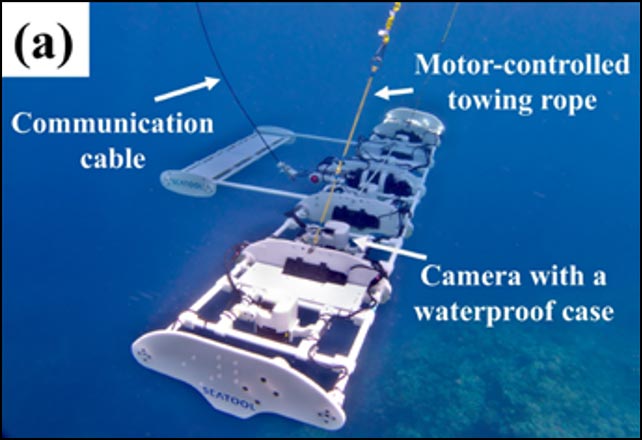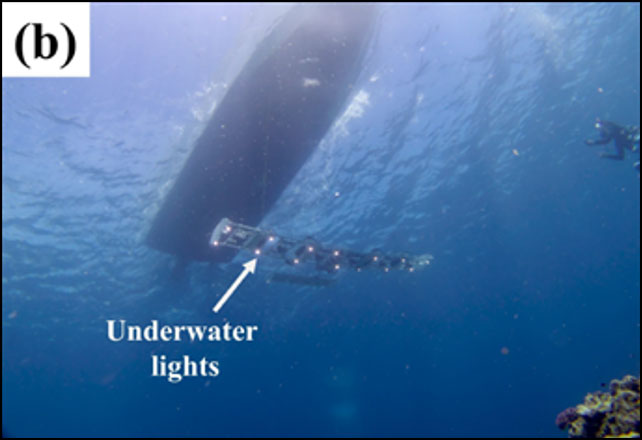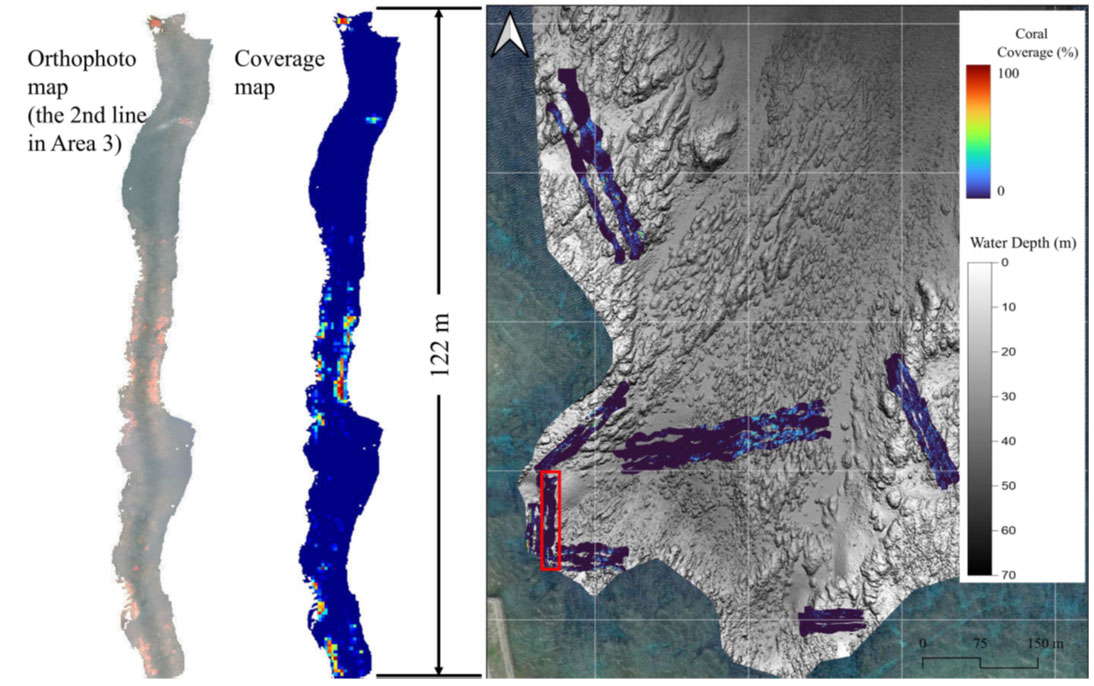- JP
- EN
MOL, Research Partners Achieve Efficient, High-precision Seabed Observation of Cold Discharge Water from Ocean Thermal Energy Conversion
- Joint Findings Published in International Academic Journal -
September 24, 2025

TOKYO-Mitsui O.S.K. Lines, Ltd. (MOL; President & CEO: Takeshi Hashimoto) today announced that it has conducted an environmental assessment of cooling water discharged from Ocean Thermal Energy Conversion (OTEC) as a joint research project with National University Corporation, the University of Tokyo (President: Teruo Fujii; Location: Bunkyo-ku, Tokyo), National University Corporation University of the Ryukyu (President: Ikue Kina; Location: Nakagami-gun, Okinawa Prefecture), and the National Research and Development Agency Japan Science and Technology Agency (JST; President: Kazuhito Hashimoto; Headquarters: Kawaguchi-shi, Saitama Prefecture).
This assessment applied a new system for observing coral distribution and seafloor topography, along with an AI model for estimating coral cover. The technical paper outlining these findings was published in The International Journal of Applied Earth Observation and Geoinformation (Note 1). This initiative aims to ensure the appropriate management of cold wastewater generated by the OTEC and Deep-Ocean Water projects MOL is promoting. To support this initiative, MOL established an independent review committee (Note 2) and has been conducting literature reviews, regulatory investigations, coral distribution surveys, and cooling water dispersion simulations since fiscal year 2024 (Note 3).
Deep ocean water is characterized by high nutrient content, exceptional purity, and stable low temperatures, making it a promising resource for diverse applications including OTEC, aquaculture, agriculture, and air conditioning. To enable the large-scale use of deep ocean water, it is essential to objectively assess and address the environmental impact of the resulting cold discharge water on marine ecosystems.
In this joint research, a highly efficient seafloor survey tool called the "Speedy Sea Scanner" (Figure 1; jointly developed by the University of Tokyo and Windy Network Co., Ltd.), and "Coral-Lab" a newly developed segmentation model (Note 4), enabled fully automated coral reef identification and coral cover calculation across a wide survey area (Figure 2).
Figure 1: The seafloor survey tool "Speedy Sea Scanner"


Figure 2: The coral distribution map, estimated by Coral-Lab; Coral coverage is visualized by color

The Speedy Sea Scanner is a towed camera array system consisting of six underwater single lens reflex (SLR) cameras mounted on a dedicated frame. Towed behind a small vessel, this system rapidly captures continuous, high-resolution photographs of the seafloor, efficiently covering wide areas in a short time. Coral-Lab is a segmentation model that is "trained" using coral images collected from diverse marine regions worldwide, combined with historical and current images from the survey area. This enables the precise detection of coral. Traditionally, surveys have required observations by divers and other personnel. However, the new method allows swift and efficient wide-area topographic and coral distribution surveys. This contributes to the achievement of rapid and accurate marine environmental assessments.
MOL will continue identifying discharge points for deep seawater and establishing monitoring methods, thereby advancing the development of countermeasures proportionate to the impact on the marine environment.
The MOL Group has set "Achieving net-zero GHG emissions with the concerted effort throughout the Group by 2050" as a medium-to-long-term target in its "MOL Group Environmental Vision 2.2" and will pursue five strategies to realize this target. Through its commitment to developing the OTEC and deep-sea water business, the group will further advance the strategic initiative of "expanding low-carbon/decarbonized business by leveraging the group's collective strengths," and address the critical issues of "preservation of the marine environment" and "protection of biodiversity."
(Note 1) The International Journal of Applied Earth Observation and Geoinformation is an international academic journal that publishes cutting-edge research on remote sensing related to natural resources and the environment utilizing Earth observation data.
Published Article Title: "Multi-dataset-integrated Coral-Lab segmentation with enhanced towed camera array for rapid large-scale coral reef monitoring and mapping"
Authors: Jiaqi Wang, Katsunori Mizuno*, Shigeru Tabeta, Tetsushi Matsuoka, Tomo Odake, Satoshi Igei, Taro Uejo, Takashi Nakamura
(Note 2) The review committee consists of representatives from the University of Tokyo, the University of the Ryukyus, Saga University, Osaka Metropolitan University, Kumejima Town, and Genesis, with the Ministry of the Environment participating as an observer.
(Note 3) Includes surveys conducted under the FY2024 Regional Co-creation and Cross-sectoral Carbon Neutrality Technology Research and Development Program commissioned to MOL by the Ministry of the Environment, Government of Japan.
For details, please refer to the March 24, 2023 press release:
Ocean Thermal Energy Conversion Demonstration Project in Okinawa Selected by Japan's Ministry of the Environment - Aiming to Commercialize World's 1st Ocean Thermal Energy Conversion by around 2026 - | MOL
(Note 4) AI capable of identifying the location and content of objects within images or videos.
This research was conducted with support from the Japan Science and Technology Agency (JST) Strategic Basic Research Program (Sakigake) "Development of Innovative 3D Structural Observation Tools for Submarine Ecosystems" (Project Number: JPMJPR24G9).
